
THE CAMAMU BAY / THE ISLANDS
The Camamu Bay is Brazil's third biggest bay, after Todos os Santos (Bahia) and Guanabara (Rio de Janeiro). It is a sanctuary of preserved nature and wild life, with beautiful landscapes, mangroves, forests and many islands. With constant winds and deep calm water, the bay provides good conditions to sail and many safe points to anchor.
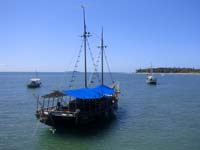 BOAT TRIPS ON THE BAY
BOAT TRIPS ON THE BAY
Traveling by boat is the best way to discover this paradise.
Motorboats can be rented in the ports of Barra Grande and Camamu.
During the tourist season, escunas (traditional wooden-made sailing ships) organize mini-cruisings for groups. Trips on the bay should begin early in the morning to completely enjoy the day.
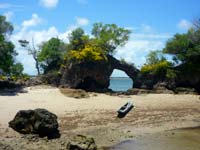 ILHA DA PEDRA FURADA
ILHA DA PEDRA FURADA
Located at 30 minutes by boat from Barra Grande and 1 hour
from Camamu, this tiny island got its name from a large stone dug by erosion.
"Pedra Furada" means "Pierced Rock" in Portuguese.
There is a natural water spring and a beach with coral reefs.
A small restaurant serves typical regional food, but it is often closed.
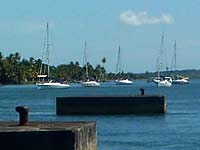 CAMPINHO
CAMPINHO
Located at 3 kilometers from Barra Grande, the small village
of Campinhos is known for the house where Antoine de Saint-Exupéry stayed in the 1930's.
Because of its very deep water, Campinho almost became an industrial port in the 1960's.
Fortunately, the port was transferred to Ilhéus.
With calm clear water and a rich submarine fauna, Campinhos
is one of the best places around for diving.
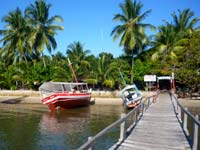 SAPINHO AND GOIÓ ISLAND
SAPINHO AND GOIÓ ISLAND
The village of Sapinho is located deeper in the bay, where mangrove is more abundant.
Some bar-restaurants serve fried fish, crabs, lobsters and traditional moquecas with coconut milk and palm oil. All the boats that take tourists on the bay stop there.
From Sapinho, it is easy to go to Goió island, which is a few yards from the village. This tiny island has a beautiful long deserted beach.
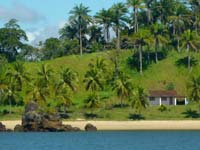 ILHA GRANDE
ILHA GRANDE
Ilha Grande ("Great Island" in Portuguese) is the biggest island of the bay, measuring
about 4 km². It is also the most populated, with approximately 1500
inhabitants. There is a port, beaches with calm and
clean water, some houses and lodges, but no cars. The streets are simple tracks made for pedestrians. Walking is the best way to discover the island.
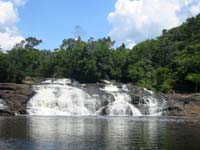 GOING FURTHER INTO THE CAMAMU BAY
GOING FURTHER INTO THE CAMAMU BAY
Pedra Furada, Campinho, Sapinho and Ilha Grande are the easiest places to go from Barra Grande. There are many more interesting places in the bay but it is not possible to visit all of them in only one day. Small motorboats may be rented to go more deeply in the bay, with more time to discover small hidden places like Barcelos do Sul, O Tanque, Cajaíba, Âmbar, Ilha das Flores, Ilha Pequena and other more distant like Rio Maraú and the waterfall of Tremembé.
 THE TOWN OF CAMAMU
THE TOWN OF CAMAMU
Port of departure to Barra Grande and the Camamu Bay, the town of Camamu is located on the Acaraí river in a sector of mangroves. Camamu is an old colonial city. It was built on two stages, like Salvador: in the high city, the
church and old colonial houses, in the low city, the port and the fish market.
For many tourists, Camamu is just a crossing point. They prefer to go directly to Barra Grande or to the beaches of the Maraú Peninsula.
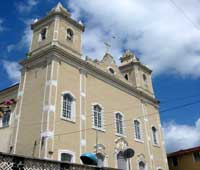 HISTORY
HISTORY
Fisrt called "Nossa Senhora de Conceição Macamamu", the town was founded in 1561 by the Jesuits on a site then occupied by the Macamamus Indians.
The Jesuits developed agriculture so that Camamu became the largest manioc producer of Brazil.
Its richness attracted the covetousness of pirates and other invaders.
In 1624 and 1627 it suffered several attacks from the Dutches.
To protect itself from new invasions, the population blocked the access to the port with huge rocks which remained there. Today, the boats are still forced to zigzag between the rocks to reach the port.

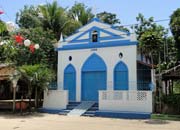
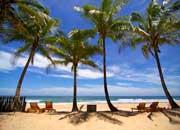

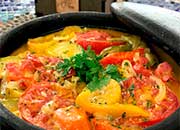
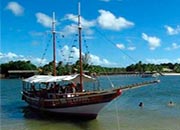

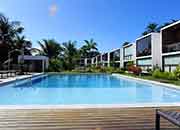
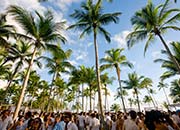


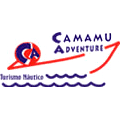

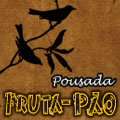
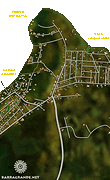
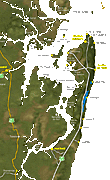
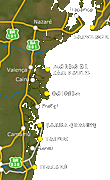
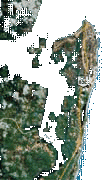
 este site em Português
este site em Português este sitio en Español
este sitio en Español ce site en Français
ce site en Français